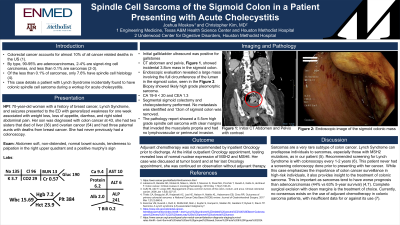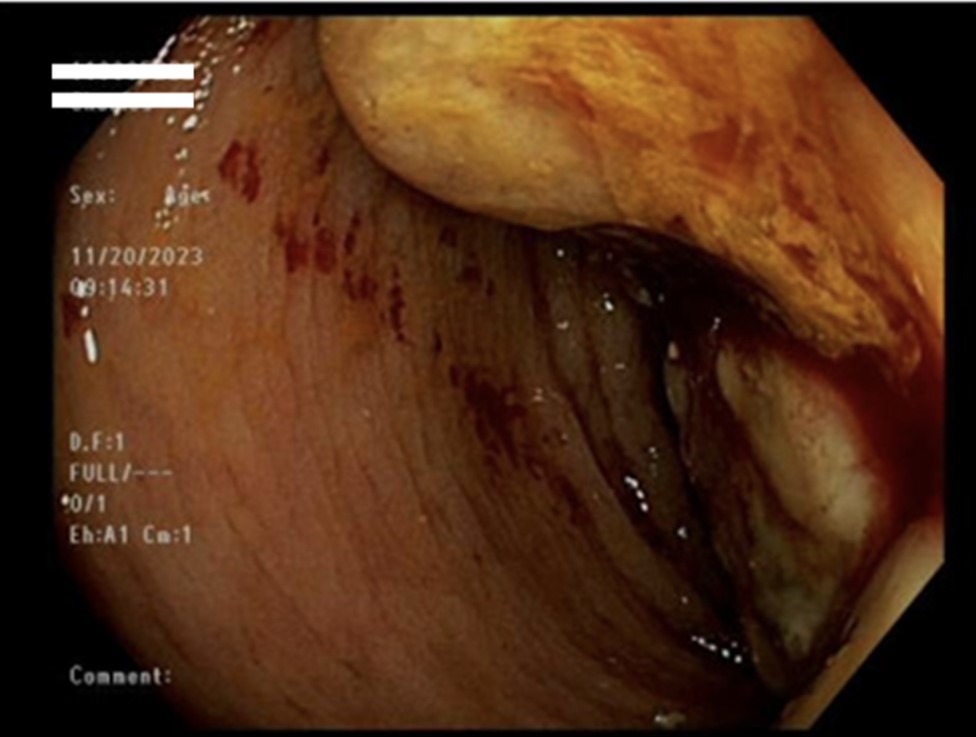Sunday Poster Session
Category: Colon
P0270 - Spindle Cell Sarcoma of the Sigmoid Colon in a Patient Presenting With Acute Cholecystitis
Sunday, October 27, 2024
3:30 PM - 7:00 PM ET
Location: Exhibit Hall E

Has Audio

Joshua Moskow, BS
Engineering Medicine, Texas A&M Health Science Center
Houston, TX
Presenting Author(s)
Joshua Moskow, BS1, Christopher Kim, MD2
1Engineering Medicine, Texas A&M Health Science Center, Houston, TX; 2Underwood Center for Digestive Disorders, Houston Methodist Hospital, Houston, TX
Introduction: Colorectal cancer accounts for almost 10% of all cancer related deaths in the US. By type, 90-95% are adenocarcinomas, 2-4% are signet-ring cell carcinomas, and less than 0.1% are sarcomas. Of the less than 0.1% of sarcomas, only 7.6% have spindle cell histology. This case details a patient with Lynch Syndrome incidentally found to have colonic spindle cell sarcoma during a workup for acute cholecystitis.
Case Description/Methods: A 70-year-old woman with a history of breast cancer and Lynch Syndrome presented to the ED with weakness, RUQ pain, weight loss, and loss of appetite. Her family history included colon cancer in her son, and she had never had a colonoscopy. Initial gallbladder US was positive for gallstones and consistent with acute cholecystitis. A CT abdomen and pelvis then showed an incidental 3.8cm mass in the sigmoid colon. Endoscopic evaluation was recommended which revealed a large mass involving the full circumference of the lumen in the sigmoid colon, seen in the figure. Biopsy showed likely high grade pleomorphic sarcoma. She was taken to the OR for a segmental sigmoid colectomy and cholecystectomy. No metastasis was identified and 13cm of sigmoid colon was removed. The pathology report showed a 5.5cm high grade spindle cell sarcoma with clear margins that invaded the muscularis propria and had no lymphovascular or perineural invasion. Adjuvant chemotherapy was not recommended by inpatient Oncology prior to discharge. At the initial outpatient Oncology appointment, testing revealed loss of normal nuclear expression of MSH2 and MSH6. At her last Oncology appointment, she was continued on observation without adjuvant therapy.
Discussion: Sarcomas are a very rare subtype of colon cancer. Lynch Syndrome can predispose individuals to sarcomas, especially those with MSH2 mutations, as in our patient. Recommended screening for Lynch Syndrome is with colonoscopy every 1-2 years. This patient never had a screening colonoscopy done prior to presenting with her cancer. While this case emphasizes the importance of colon cancer surveillance in high-risk individuals, it also provides insight to the treatment of colonic sarcoma. This is important as sarcomas tend to have worse prognosis than adenocarcinomas (44% vs 63% 5-year survival). Complete surgical excision with clean margins is the treatment of choice. Currently, no consensus exists on the use of adjuvant chemotherapy in colonic sarcoma patients, with insufficient data for or against its use.

Disclosures:
Joshua Moskow, BS1, Christopher Kim, MD2. P0270 - Spindle Cell Sarcoma of the Sigmoid Colon in a Patient Presenting With Acute Cholecystitis, ACG 2024 Annual Scientific Meeting Abstracts. Philadelphia, PA: American College of Gastroenterology.
1Engineering Medicine, Texas A&M Health Science Center, Houston, TX; 2Underwood Center for Digestive Disorders, Houston Methodist Hospital, Houston, TX
Introduction: Colorectal cancer accounts for almost 10% of all cancer related deaths in the US. By type, 90-95% are adenocarcinomas, 2-4% are signet-ring cell carcinomas, and less than 0.1% are sarcomas. Of the less than 0.1% of sarcomas, only 7.6% have spindle cell histology. This case details a patient with Lynch Syndrome incidentally found to have colonic spindle cell sarcoma during a workup for acute cholecystitis.
Case Description/Methods: A 70-year-old woman with a history of breast cancer and Lynch Syndrome presented to the ED with weakness, RUQ pain, weight loss, and loss of appetite. Her family history included colon cancer in her son, and she had never had a colonoscopy. Initial gallbladder US was positive for gallstones and consistent with acute cholecystitis. A CT abdomen and pelvis then showed an incidental 3.8cm mass in the sigmoid colon. Endoscopic evaluation was recommended which revealed a large mass involving the full circumference of the lumen in the sigmoid colon, seen in the figure. Biopsy showed likely high grade pleomorphic sarcoma. She was taken to the OR for a segmental sigmoid colectomy and cholecystectomy. No metastasis was identified and 13cm of sigmoid colon was removed. The pathology report showed a 5.5cm high grade spindle cell sarcoma with clear margins that invaded the muscularis propria and had no lymphovascular or perineural invasion. Adjuvant chemotherapy was not recommended by inpatient Oncology prior to discharge. At the initial outpatient Oncology appointment, testing revealed loss of normal nuclear expression of MSH2 and MSH6. At her last Oncology appointment, she was continued on observation without adjuvant therapy.
Discussion: Sarcomas are a very rare subtype of colon cancer. Lynch Syndrome can predispose individuals to sarcomas, especially those with MSH2 mutations, as in our patient. Recommended screening for Lynch Syndrome is with colonoscopy every 1-2 years. This patient never had a screening colonoscopy done prior to presenting with her cancer. While this case emphasizes the importance of colon cancer surveillance in high-risk individuals, it also provides insight to the treatment of colonic sarcoma. This is important as sarcomas tend to have worse prognosis than adenocarcinomas (44% vs 63% 5-year survival). Complete surgical excision with clean margins is the treatment of choice. Currently, no consensus exists on the use of adjuvant chemotherapy in colonic sarcoma patients, with insufficient data for or against its use.

Figure: Figure: Sigmoid colon mass identified on colonoscopy.
Disclosures:
Joshua Moskow indicated no relevant financial relationships.
Christopher Kim indicated no relevant financial relationships.
Joshua Moskow, BS1, Christopher Kim, MD2. P0270 - Spindle Cell Sarcoma of the Sigmoid Colon in a Patient Presenting With Acute Cholecystitis, ACG 2024 Annual Scientific Meeting Abstracts. Philadelphia, PA: American College of Gastroenterology.
